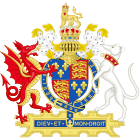| This article needs additional citations for verification. Please help improve this article by adding citations to reliable sources. Unsourced material may be challenged and removed. Find sources: "Treasons Act 1534" – news · newspapers · books · scholar · JSTOR (September 2024) (Learn how and when to remove this message) |
United Kingdom legislation
| Act of Parliament | |
 Parliament of England Parliament of England | |
| Long title | An Act whereby divers Offenses be made High Treason; and taking away all Sanctuaries for all manner of High Treason. |
|---|---|
| Citation | 26 Hen. 8. c. 13 |
| Territorial extent | Kingdom of England |
| Dates | |
| Royal assent | 18 December 1534 |
| Repealed | 28 July 1863 |
| Other legislation | |
| Repealed by | Statute Law Revision Act 1863 |
| Relates to | |
| Status: Repealed | |
| Text of statute as originally enacted | |
The Treasons Act 1534 or High Treason Act 1534 (26 Hen. 8. c. 13) was an act of the Parliament of England passed in 1534, during the reign of King Henry VIII.
Background
This act was passed after the Act of Supremacy 1534, which made the king the "Only Head of the Church of England on Earth so far as the Law of God allows."
The act
The act made it treason, punishable by death, to disavow the Act of Supremacy 1534. Sir Thomas More was executed under this Act. It was introduced as a blanket law in order to deal with the minority of cases who would refuse to accept Cromwell's and Henry's changes in policies, instead of using the more traditional method of attainders.
The act specified that all those were guilty of high treason who:
do maliciously wish, will or desire by words or writing, or by craft imagine, invent, practise, or attempt any bodily harm to be done or committed to the king's most royal person, the queen's or the heirs apparent , or to deprive them of any of their dignity, title or name of their royal estates, or slanderously and maliciously publish and pronounce, by express writing or words, that the king should be heretic, schismatic, tyrant, infidel or usurper of the crown...
The word 'maliciously' was added in several cases to require evil intent, and the Act meant that it was very dangerous to say anything against what the King had done. The Act also made it treason to rebelliously keep or withhold from the King his castles, forts, ships, or artillery, and to fail to surrender any of them within six days of being commanded to do so. It also abolished sanctuary for those accused of high treason.
Repeal
The Act was superseded and virtually repealed by the Treason Act 1543 and the Forestallers Act 1551.
The act was completely repealed by the Statute Law Revision Act 1863.
See also
References
- Lords, Great Britain Parliament House of (1863). Public Bills — Statute Law Revision Bill. p. 116.
This England-related article is a stub. You can help Misplaced Pages by expanding it. |
This legislation article is a stub. You can help Misplaced Pages by expanding it. |